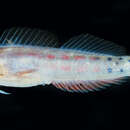Diagnostic Description
provided by Fishbase
Dorsal fin XII.14 or 15, deeply notched between spinous and segmented-ray portions. Anal fin II,16 or 17. Pectoral fin 13 or 14 (rarely 14). Segmented caudal-fin rays 13. Vertebrae 10 + 22 or 23. Dentary incisor teeth which includes anterior canine teeth very similar in appearance with incisors, 43-51; posterior dentary canines 1 on each side. Lateral line lacking pairs of pores, terminating posteriorly at point between verticals from dorsal-fin spines 8 and 11. With cirrus onposterior rim of anterior nostril; absent on anterior rim. With bilateral pair of dark spots on theventrolateral surface of the head in both males and females, and a dark, somewhat diffused, spot in the pectoral-fin axil. Lateral line generally extending slightly further posteriorly.
Life Cycle
provided by Fishbase
Oviparous, distinct pairing (Ref. 205).
Morphology
provided by Fishbase
Dorsal spines (total): 12; Dorsal soft rays (total): 14 - 15; Analspines: 2; Analsoft rays: 16 - 17; Vertebrae: 32 - 33
Biology
provided by Fishbase
Oviparous. Eggs are demersal and adhesive (Ref. 205), and are attached to the substrate via a filamentous, adhesive pad or pedestal (Ref. 94114). Larvae are planktonic, often found in shallow, coastal waters (Ref. 94114).
- Recorder
- Estelita Emily Capuli
Comprehensive Description
provided by Smithsonian Contributions to Zoology
Ecsenius isos
Ecsenius yaeyamaensis (Aoyagi).—Springer, 1971:32 [in part].
Ecsenius trilineatus Springer, 1972:2 [in part].
DESCRIPTION.—Dorsal-fin spines 12(4); segmented dorsal-fin rays 14(3), 15(1); segmented anal-fin rays 16 (4); pectoral-fin rays 13(4); segmented caudal-fin rays 13(4); dorsal procurrent caudal-fin rays 6(1), 7(2), 8(1); ventral procurrent caudal-fin rays 6(2), 7(1), 8(1); total caudal-fin elements 25(1), 26(1), 27(1), 29(1); gill rakers 13(1), 14(2); pseudobranchial filaments 5(4); dentary incisor teeth 43(1), 45(1), 46(1), 50(1); lower jaw (one side) posterior canine teeth 0(3), 1(1); total lower jaw posterior canine teeth 0(3), 2(1); precaudal vertebrae 10(4); caudal vertebrae 22(3), 23(1); epipleural ribs 11(3), 12(1). Lateral line with no paired pores, extending posteriorly to below level of 8th(1), 9th(1) or 10th(2) dorsal-fin spine. Dorsal-fin notched eight-ninths (3) length of first segmented dorsal-fin ray. Data for the holotype are given in Table 2.
Color Pattern: Head with series of diffuse, dusky markings extending from upper portion of opercle anteroventrally to underside of head (similar in position to dark head stripe of E. trilineatus), ventralmost mark in series is a prominent spot. Scattered dusky pigment and very diffuse spots elsewhere on side of head. Lower lip dusky anteriorly. Body with two rows of diffuse, dusky blotches, which grade into smaller, more discrete spots posteriorly; spots in the two rows faintly connected as if to form bars; slight amount of dusky pigment extending from posteriormost spots of both rows out on proximal portion of caudal fin; caudal fin otherwise immaculate. Fleshy pectoral-fin base with diffuse dusky marks; upper mark along dorsal margin of fin base, lower mark at mid-base and extending onto base of middle ray as dark spot; pectoral fin otherwise unmarked. Narrow dusky stripe on both spinous and segmented-ray portions of dorsal fin just distal to fin base (prominent on males, faint on females). Distal margin of segmented-ray portion of dorsal fin with dusky stripe. Anal fin with broad dusky stripe, tips of rays pale. Pelvic fins unmarked.
RELATIONSHIPS.—The specimen designated below as the holotype of E. isos was tentatively identified by Springer (1972) as E. trilineatus in his description of that species. The paratypes were treated by Springer (1971) as color pattern variants of E. yaeyamaensis (as were specimens of the then undescribed E. trilineatus) and were overlooked in the 1972 study. The specimens of E. isos were confused with E. yaeyamaensis and E. trilineatus because the specimens have diffuse, but similar, markings on the fleshy pectoral-fin base. However, E. isos belongs in the prooculis subgroup of the yaeyamaensis species group by virtue of its having a short lateral line, short nasal cirri and discrete dark spots on the ventral surface of the head. E. isos is the only member of the prooculis subgroup that has dark spots beneath the head in both sexes. In overall coloration, E. isos most closely resembles E. collettei but differs from the latter by having diffuse dusky marks on the pectoral-fin base, a narrow dusky stripe in the spinous portion of the dorsal fin and a series of dusky markings extending from the upper opercle anteroventrally to the underside of the head. Also, the anterior markings on the body of E. isos are much less discrete than those of E. collettei.
- bibliographic citation
- McKinney, James F. and Springer, Victor G. 1976. "Four new species of the fish genus Ecsenius with notes on other species of the genus (Blenniidae, Salariini)." Smithsonian Contributions to Zoology. 1-27. https://doi.org/10.5479/si.00810282.236
Ecsenius isos: Brief Summary
provided by wikipedia EN
Ecsenius isos is a species of combtooth blenny in the genus Ecsenius. It is found in coral reefs in the western central Pacific ocean, around New Hebrides and New Caledonia. It can reach a maximum length of 3.2 centimetres. Blennies in this species primarily feed off of plants, including benthic algae and weeds. The specific name isos refers to the dark spots beneath the blennies' heads.
- license
- cc-by-sa-3.0
- copyright
- Wikipedia authors and editors

